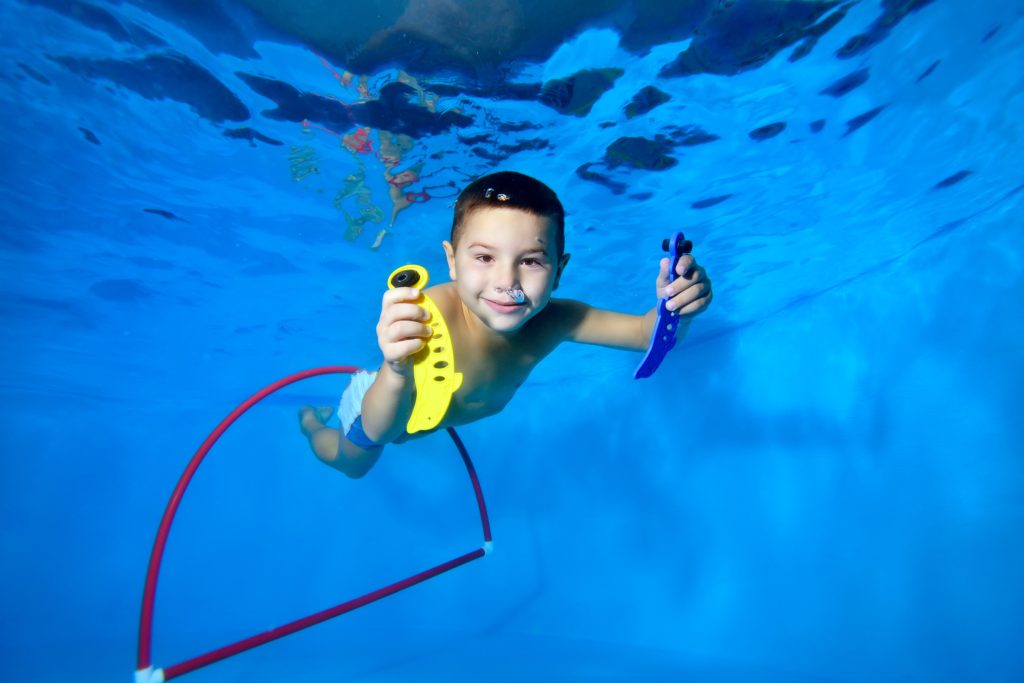A swimmer can drown in less than a minute. This means that responding quickly to a swimmer in distress is the only way to save lives. Fortunately, today we can leverage game-changing technologies, such as artificial intelligenceד and smart devices, to develop drowning prevention tools. In doing so, we shift our efforts from detection to prevention, enabling lifeguards to act within that short window of time to respond to a swimmer in distress.
This article will discuss the pros and cons of smart wearables compared to drowning prevention systems utilizing cameras.
Smart Wearables for Pool Safety
Wearable smart devices are being used for everything from monitoring diabetes to tracking fitness goals. So it is only fitting that they’ve been established as tools for swimming safety.
The most popular drowning detection wearables currently on the market come with only a few components that are implemented in the pool environment.
Swimmers wear tracker headsets, goggle clips, wristbands, or collars that are non-intrusive, light, and comfortable.
But how do these wearables work?
- Swimmers wear wireless, waterproof, rechargeable devices.
- A monitoring receiver is placed near the swimming pool.
- The receiver constantly monitors the wearables via Bluetooth technology.
- When the swimmer is submerged, the water blocks the signal.
- At this point, the receiver “knows” that the swimmer is underwater. When the swimmer resurfaces, communication with the receiver is re-established.
- If the swimmer remains submerged for a “high-risk” length of time, the lifeguard’s wristband vibrates, the receiver emits an audible alert, and flashes.
- The lifeguard races to find the swimmer in distress and intervene.
Other smart pool systems rely on Bluetooth technology that enables the wearables to provide location data for swimmers, which is then transmitted to lifeguards and staff via tablets or smartwatches.
If a swimmer remains submerged for more than 30 seconds, the screens on the tablets flash red and vibrate. A warning alert is sent, and the swimming lane is identified so the lifeguard can immediately save the swimmer.
A more low-tech version of wearables includes armbands and neck bands that sound an alarm if a swimmer reaches a certain depth or stays submerged for too long.

Pros
- Easy to use
- Easy to setup and operate
- Simple technology
- Perfect for low budgets
Cons
- Wearables can slip off, so parents must constantly monitor their children in the pool.
- Most wearables don’t provide location information
- The technology cannot identify early signs of water distress. Instead, it relies upon the loss of a wireless signal, suggesting that a swimmer is submerged for a dangerous length of time.
- In some cases, up to 30 seconds can elapse before an alarm is triggered.
Standard Overhead Security Cameras (CCTV)
While standard security cameras are used at swimming pools worldwide, their function is limited. CCTV cameras provide excellent feedback for security and management due to their ability to see the swimmers in the pool, but they cannot do anything else.
Pros
- Can record security incidents, such as unauthorized entry, theft, etc.
- Provide a live view of the pool
Cons
- Cannot see under the water’s surface.
- Cannot track and identify swimmer behavior.
- Inability to actively alert lifeguards to swimmers in distress.
AI-Powered CCTV Cameras
CCTV cameras powered by artificial intelligence are a groundbreaking drowning prevention technology being implemented at swimming pools worldwide. Swimming pool managers can easily transform their existing CCTV cameras into a groundbreaking drowning prevention tool that prioritizes drowning prevention over drowning detection.
- The CCTV camera tracks and monitors all swimmers in the pool.
- AI software digitizes and analyzes the images captured by the camera.
- Machine learning algorithms compare a swimmer’s motions to a database to calculate how likely the swimmer is to be in distress.
- An alert is immediately transmitted to a dedicated smartwatch worn by lifeguards.
- The smartwatch also displays an automatic snapshot of the distressed swimmer and the precise location, making it easy to quickly intervene even when there are many swimmers in the pool.
Pros
- AI-powered CCTV cameras can track and monitor all swimmers, no matter where they are in the pool, and regardless of ripples, glare, and splashes in the water.
- Timely alerts empower lifeguards to intervene with a swimmer in distress, before a drowning occurs.
- System setup is short and simple, and does not require closing the facility.
- Seamless for swimmers and staff.
- User-friendly for lifeguards.
- AI-powered CCTV cameras also provide pool managers with water surface analytics data to help them improve the pool experience for everyone, for instance, by alleviating crowding during popular hours, and ensuring efficient staffing and maintenance activities.

Conclusion
According to the CDC, there has been virtually no reduction in the number of children drowning in swimming pools over the past 20 years. Drowning continues to be the second-leading cause of injury-related death for children ages 1 to 14 years. And almost half of these children drown in guarded pools.
While wearables and overhead security cameras offer swimmers some protection, they do not provide parents and pool managers with the peace of mind they seek.
To conclude, AI-powered CCTV cameras enable lifeguards to act before a drowning occurs and do the job that wearables and standard security cameras cannot.
